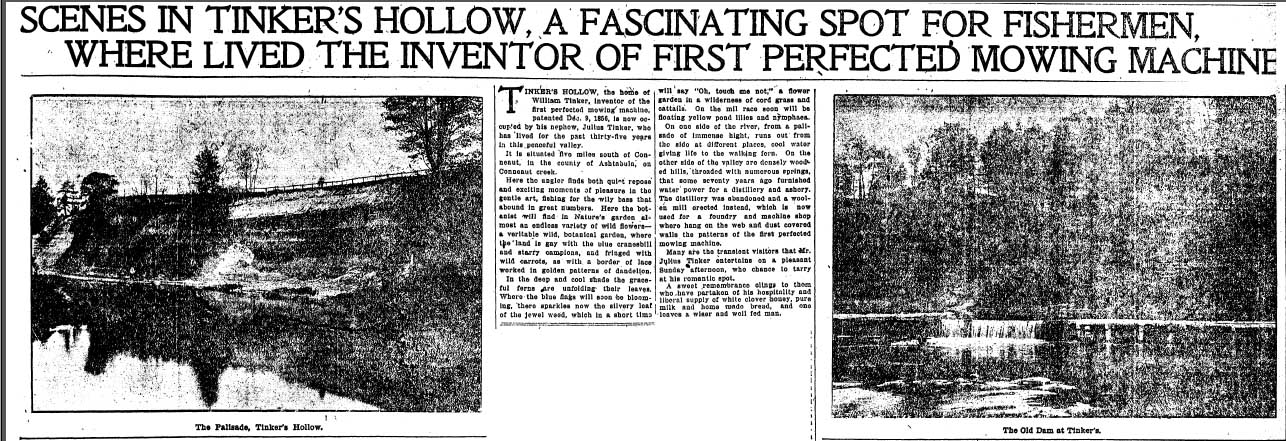
| CONNEAUT, OHIO HISTORY & GENEALOGY...................... |
The following article was found in the Plain Dealer, Cleveland, OH on June 8,
1902 - Page 41:

The article above reads as follows:
TINKER'S HOLLOW, the home of William Tinker,
inventor of the first perfected mowing machine, patented Dec. 9, 1856, is now
occupied by his nephew, Julius Tinker, who has lived for the past
thirty-five years in this peaceful valley.
It is situated five miles south of Conneaut, in the
county of Ashtabula, on Conneaut creek.
Here the angler finds both quiet repose and exciting
moments of pleasure in the gentle art, fishing for the wily bass that abound in
great numbers. Here the botanist will find in Nature's garden almost an
endless variety of wild flowers - a veritable wild, botanical garden, where the
land is gay with the blue cranesbill and starry campions, and fringed with wild
carrots, as with a border of lace worked in golden patterns of dandelion.
In the deep and cool shade the graceful ferns are
unfolding their leaves. Where the blue flags will soon be blooming, there
sparkles now the silvery leaf of the jewel weed, which in a short time will say
"Oh, touch me not," a flower garden in the wilderness of cord grass and
cattails. On the mil race soon will be floating yellow pond lillies and
nymphaes.
On one side of the river, from a palisade of immense
height, runs out from the side at different places, cool water giving life to
the walking fern. On the other side of the valley are densely wooded
hills, threaded with numerous springs, that some seventy years ago furnished
water power for a distillery and ashery. The distillery was abandoned and
a woolen mill erected instead, which is now used for a foundry and machine shop
where hang on the web and dust covered walls the patterns of the first perfected
mowing machines.
Many are the transient visitors that Mr. Julius
Tinker entertains on a pleasant Sunday afternoon, who chance to tarry at his
romantic spot.
A sweet remembrance clings to them who have partaken of
his hospitality and liberal supply of white clover honey, pure milk and home
made bread, and one loaves a wiser and well fed man.
-------------------------------------
This article was found in Plain Dealer, Cleveland, OH on Aug. 18, 1929 - pg. 1:
WORK IN IRON FOR 115 YEARS AT CONNEAUT - Members of Tinker
Family Still Practice in Arts Begun by Backsliding Sailor Forbear.
SECRET OF HARDENING IRON ISN'T REVEALED. - Only One Man Now Knows It;
Hollow Made Famous by Two Brothers.
By John W. Vance. (Staff Correspondent)
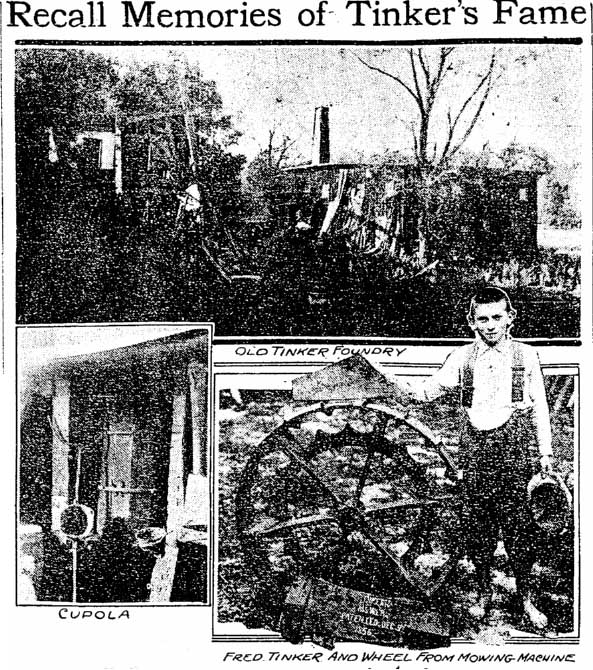
BY TINKER FAMILY
CONNEAUT, O., Aug. 17. - When a British tar, who was also a blacksmith and
homesick for the bitter smell of hot iron, jumped overboard from the deck of one
of his majesty's frigates on an early evening in 1812 and struck out for the
distant beach of Boston Harbor, he probably had no intention of founding a
dynasty of his own.
The backsliding sailor's name was Tinker
His first name is not known to the current members of his house, but still the
dominant factor in the lives of his descendants, who have been doing
unprecedented things with iron for 115 years at their home in Tinker's Hollow
five miles southwest of Conneaut.
The original Tinker, removing himself as far as
possible from ships whose deck had to be holystoned every day, reached Conneaut
some time about two years later.
Built Big Workshop.
He found Tinker's Hollow and built himself,
first, a small house, and second, a big workshop on a ridge to the south of the
hollow just above Conneaut Creek. His further deeds are lost to history.
It is probably that he died of old age, for the
Tinkers are noted, among other things, for their longevity.
He left, however, two sons, William and
Sylvester, who could swing a hammer with the best. They were men of
inquiring minds and one of the things that puzzled them was way a farmer should
do any ore manual labor than could be avoided. The idea of a mechanical
mowing machine was born.
They had a new foundry, erected in 1835; they had an
iron cupola furnace, built four years later, and they had a suspicion that their
neighbors' sneers were misplaced and that a mowing machine that would work was
going to be made.
The foundry is still standing to house the work of the
present William Tinker, grandson of Sylvester. The cupola,
90 years old, the oldest in Ohio, is still fired to melt iron for its owner.
The mowing machine is gone.
William Tinker was the mechanic of the two.
Sylvester the salesman. They made a lathe for turning their
patterns, which is still in use. They diverted the waters of Conneaut
Creek and provided a ill race to turn the lathe. They designed their
mower.
A group of farmers in a hay field near Conneaut were
startled one July morning in 1853 by a dust cloud coming down the road.
The cloud was not unusual, but it was surmounted by
what looked like a plug hat. Two fat bay horses trotted in front.
Something long and thin struck out at the side.
The odd looking affair turned into the field, the dust settled, and there was
Sylvester Tinker grinning at them over the horses' cars. He was seated
on the first Tinker mowing machine.
The mower was built around a wheel 40 inches high.
Within the rim of the wheel ran a continuous s-shaped track. An arm, with
a roller attached, fitted into the track. As the wheel revolved, the
irregularity of the track gave the arm a forward and backward motion.
How It Worked.
The arm was attached to what is called a section
bar. This projects horizontally at a height regulated by the driver of the
mower. The section bar on the Tinker machine was five feet long and
cut a swath of about four feet.
A small wheel at the outer end balanced the large wheel
so that the machine could be drawn along.
The operation of the cutter, or section bar, was
similar to that of the clippers the barber uses on the back of your neck.
Instead of a set of moving points crossing over a set
of stationary ones, however, the Tinker machine had a middle bar of
moving points passing between two rows of fixed ones. The points are iron
equilateral triangles and are about four inches long on each side.
Pulled by two horses, a new machine would cut the
heaviest grass. Its success was great but largely local.
The Tinkers built about 30 machines a year
during the Civil War period and for a few years afterward.
About 150 or 200 tons of iron was the annual
consumption. The pig iron was brought to Conneaut Harbor from Buffalo in
sailing vessels.
Foundry Is Moved.
The old foundry of the original Tinker was
moved down from its ridge and established about the mill race to serve as an
assembling plant. This was manned by boys.
As many as twenty men were employed in making the parts
for the mower. They were unusually well paid - some of them as much as $3
a day, a fabulous wage for those days.
The Ford plan was not followed. Each man could
and did pour and cast any part of the machine.
The mower was doomed, however, for the famous McCormick
reaper with its whirling bars appeared in the '70s. The sales of the
Tinker product fell off.
The mower had been patented in 1856, three years after
its invention. The brothers revised it, employing some modifications of
McCormick's ideas, but were unable to obtain a patent.
They did patent parts of it, however. They were
the first to invent removable points for the section bar. They were also
the first devisers of detachable wooden guards for the stationary points.
These guards were shaped like round spearheads with a slot, and slipped on over
the points.
Built Steam Engine.
In addition to the mowing machine, the Tinkers
made a steam engine, stoves, plows, drag saws and saw mills, an apple slicer,
and a small thresher, which was operated through a system of gears on power
furnished by horses walking around it in circles.
The apple slicer was rather like a nutmeg grater,
turned inside out. It had an enormous ale among country housewives 50
years ago, when many of them made their winter money by slicing and drying
apples for export.
The machine consisted of two parallel wooden slats,
between which ran another strip of wood.
At the bottom of this strip, a common nail projected.
The apple was spitted on this. As the middle strip with the apple in
position was shoved downward it encountered strips of metal curved from one side
piece to the other with a sharpened edge turned up. Each of these four
strips was smaller than the last.
The effect was that of shoving the fruit through a
series of lessening circles. At the bottom was a small hole through which
the core tumbled out.
Only One Knows Secret.
William and Sylvester had done, in addition to
their inventions, one other remarkable thing.
They had discovered a way to make their iron nearly as
hard as steel. It was their own secret and they let no one else in on it.
No one, that is, except the late Julius Tinker,
father of the present William, and son of Sylvester.
Julius Tinker died June 8, of this year at the age
of 82, but not before he had taught the secret to his son. William
is the only one who now knows the process.
William Tinker now and then puts charcoal
and pig iron in the top of his 90-year-old cupola, turns on the air current, and
melts a little iron for plow points. He manufactures them almost
exclusively, save for an occasional set of sleigh runners turned out.
A plow point is a triangular, pointed and slightly
concave plat of metal, which fits at the head of the share and does the actual
digging.
Much Cheaper Than Steel.
An ordinary iron point will last for perhaps 70
acres of plowing in the sandy soil around Conneaut. Those of William
Tinker have gone more than 250 acres.
One set of points has been in use three yeas and is
still going strong. The iron points Tinker makes are about
one-third as expensive as steel ones.
William Tinker pours them in the same ladies
used by his father, his grandfather, and for all anyone knows, the original
Tinker. Anybody can watch him.
His secret cannot be detected by the eye. Neither
can it be written down like a chemical formula. You have to know how.
Several attempts have been made by plow company agents
to surprise the trick out of the practicing members of the Tinker Family.
The agents have watched everything done as it
ordinarily is, observing no divergence. Then they have picked up a point,
struck it, heard it ring like a chime and gone sorrowfully away, with the
laughter of the family pursuing them.
Likes to Tease Them.
"I like to tease them," William Tinker
said. "One man came here from the N__ Plow Co., one of the largest.
He was all dressed p, diamonds on his fingers. I knew he didn't belong
around here. He asked if he could come in. I told him 'sure': it
wasn't any farther from him to me than from me to him.
"He watched for a long time. Finally he said,
'I'd like to know how you do that.' I said. 'Well, I'll tell you. I
pour from this side of the ladle then from the other side. The iron that
comes out this side is just ordinary, but the other side is hard as steel.'
He said. 'Ah, what causes that? So I told him. "Well, you see. that
side of the ladle is cold." The agent went away from there.
One ladle will yield soft, ordinary cast iron.
The other will be the steel-like product for which he is famous.
"It must be in the pouring, isn't it?" the
reporter asked. William Tinker winked and said nothing.
Freddy Tinker, 13, stood near-by.
Clayton, 16, the other son, was not about. Clayton does not
follow the family tradition. He wants to be a dairy farmer.
His father regrets this, for he feels that Clayton
would be good at the trade.
Freddy is a Tinker, through and through.
The reporter asked him if he knew the secret - if he was going to continue the
making of Tinker iron. Freddy grinned.
"I guess prob'ly I will, soon as my dad gets time to
teach me." said the fifth generation of the Tinkers of Tinker Hollow,
and looked up at the black sides of the old cupola.
THE FOLLOWING TOMBSTONES MADE BY TINKER were photographed by Sharon Wick:
Made by Tinker they are the special metal that doesn't rust.
Sweany / Puffer / Catlin Tombstone found in City Cemetery, Conneaut, OH
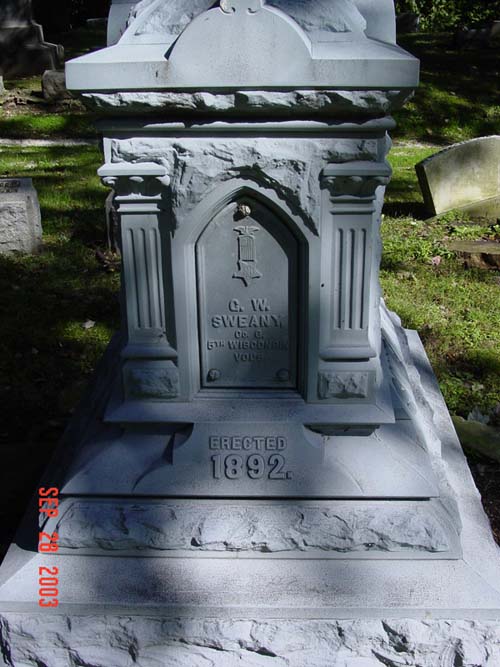
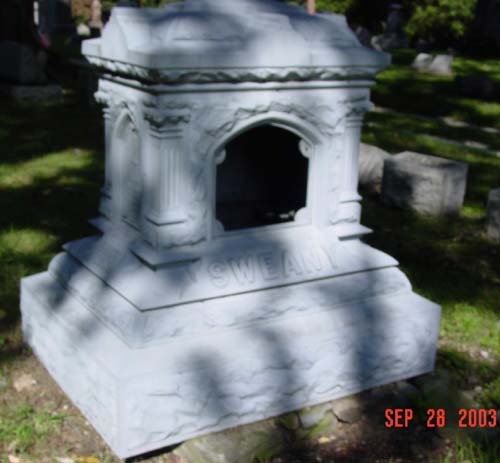
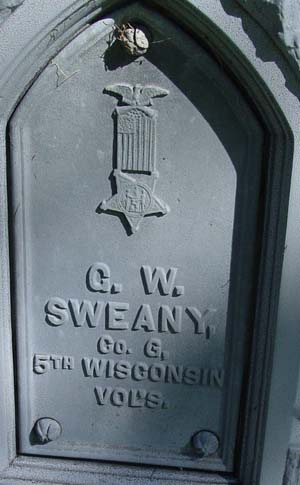
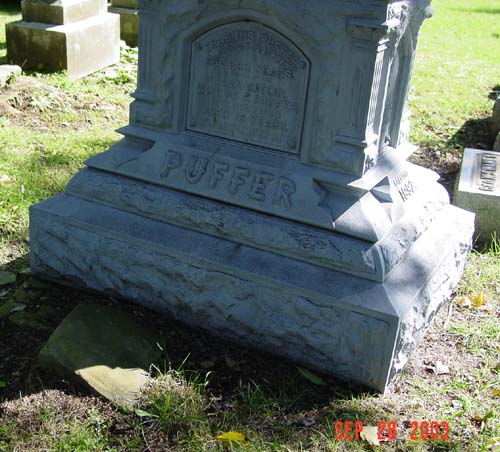
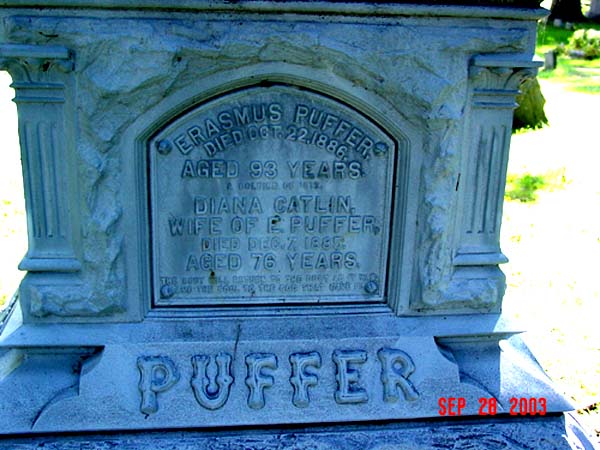
There are more of the Tinker Tombstones in City Cemetery and most of the other
nearby cemeteries including West Springfield, PA